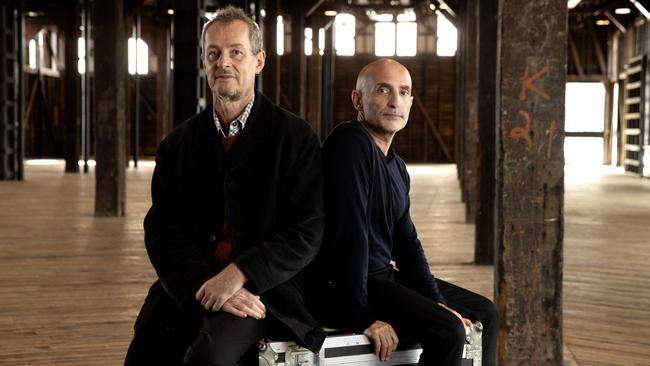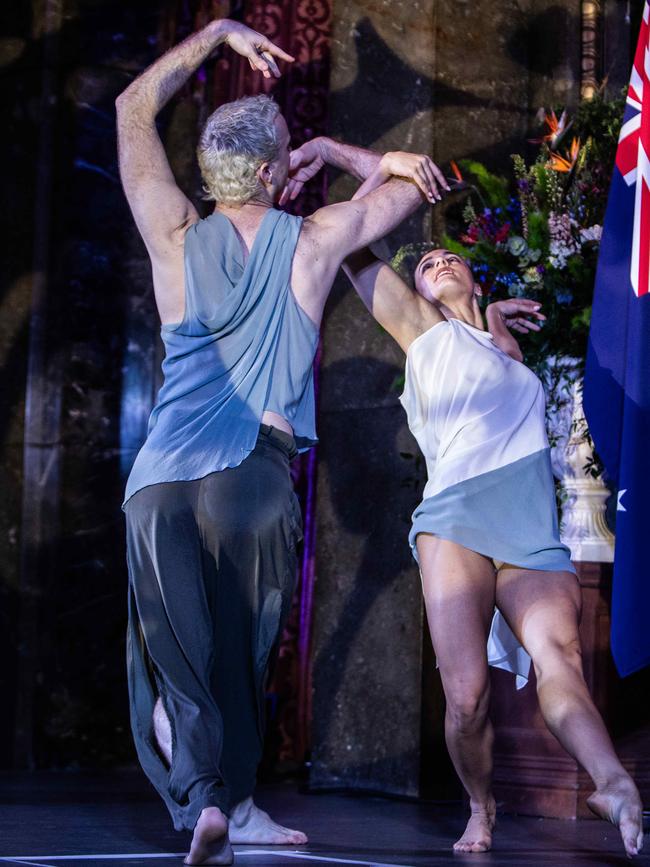Tognetti’s orchestra and Bonachela’s dancers are to bring us Part and JS Bach in Silence & Rapture
A spectacular collaboration between Rafael Bonachela’s Sydney Dance Company and Richard Tognetti’s Australian Chamber Orchestra celebrates the music of Arvo Part and JS Bach.

When Rafael Bonachela was a young boy growing up in the Spanish town of La Garriga near Barcelona he regularly sang with the local church choir, an experience that would later have a profound impact.
“I was in the founding year of this choir, a significant thing for the town. It was Catholic music, and I just loved it,” he says.
His family was not remotely religious – his parents had lived under dictator Francisco Franco’s iron rule – and Bonachela grew up without a religious or musical education beyond his father’s beloved flamenco which, in his youth, Bonachela rejected outright. He ultimately drifted away from the choir at 14 to pursue his love of dance and pop music, Madonna and Michael Jackson in particular. A few years later, in 1989, when he was touring Budapest as a professional dancer with the Barcelona-based contemporary dance company Lanonima Imperial, several of the older dancers brought with them and played a handful of vinyl records, including those of JS Bach. Bonachela, in turn, became interested in Catalan cellist Pablo Casal’s interpretation of Bach’s Cello Suites. He was captivated.
“Pablo Casal’s cello suites were one of the first things I attempted to choreograph! I should have stuck with soundscapes,” Bonachela says with a laugh. “I was so in love with that music, as a young, young wannabe, will make it/won’t make it/who knows … but I had a dream.”
That dream was made only richer when Bonachela joined London’s Rambert Dance Company in 1992 and experienced first-hand the joy and inspiration of creating choreography for live music.
Fast forward three decades and Bonachela – now choreographer and artistic director of Sydney Dance Company – had to pinch himself when Australian Chamber Orchestra artistic director and lead violin Richard Tognetti approached him about collaborating on a production involving dancers and musicians performing live the music of Bach and Arvo Part.
“It’s music that has been with me a long time, so for Richard coming to me now with this dream project, dream set list of music … it doesn’t happen very often. We had to make it happen.”
That was 18 months ago, when Tognetti and his orchestra, the newest residents in Sydney’s Walsh Bay arts precinct, were looking for a joint project with their contemporary dance neighbours. Tognetti knew the answer had to be Bach and Part.
Why? “Because Part is the 20th-century successor to Bach in the use of music. And Bach is the greatest of all composers. And I deliberately say is, not was, although he very much was,” Tognetti states.
The result is Silence & Rapture, an aural and visual spectacular that brings together Grammy Award-winning British countertenor Iestyn Davies, the ACO and SDC senior dancers Liam Green and Emily Seymour in a production that explores the human experience through the powerful, evocative and ethereal music of Bach and Part, composers born three centuries apart whose music nevertheless still transports audiences from hope and temptation to tragedy and passion, joy and redemption.
It is nearly a decade since the ACO and SDC last collaborated, on Illuminated, the 2015 production of three works marrying movement, live music and vocals from Katie Noonan. That followed the critically acclaimed Project Rameau in 2012, the companies’ first co-production, that vividly brought to life the physicality of the music of French baroque composer Jean-Philippe Rameau.
The Covid shutdown and relentlessly busy schedules of both these national and internationally touring performing arts companies meant it has taken until now to realise a third collaboration.
While Silence & Rapture doesn’t follow a narrative, Tognetti has structured the program to have a natural narrative arc, formed by three main chapters and bookended by a prelude and epilogue including various arias and hymns sung by Davies.
“If it’s going to be Bach and Part it has to be biblical,” Tognetti says of the German late baroque composer and musician and his Estonian contemporary classical counterpart, whose music is inspired in part by Gregorian chant.

While Bach needs no introduction, Part’s distinctive, otherworldly music is better known than you may expect: he was the world’s most performed living composer between 2010 and last year, when he was knocked off his pedestal by John Williams. Part is now 88, and his music has inspired everyone from Nick Cave to Bjork and PJ Harvey, while British choreographer Christopher Wheeldon introduced a whole new classical ballet audience to his music through Wheeldon’s pas de deux After the Rain (Spiegel im spiegel). “Arvo Part’s music forms an incredibly important part of the musical psyche of the last 50 years,” Tognetti says.
“His style is almost an island unto itself and provides an antidote, if you like, to 20th-century modernism, while sitting in perfect resonance with the music of JS Bach, who is himself a god-like figure to musicians.”
Each chapter of Silence & Rapture is set in a biblical garden (Garden of Eden, Garden of Gethsemane and Garden of Heaven), following a Lutheran metaphor well known in Bach’s time of the world as a pendulum, swinging downward to tragedy and passion and ultimately upward again to redemption and resurrection. The score moves from Bach’s Sonata for Violin and Keyboard No 2 in A major to Part’s Fratres, the St Matthew Passion aria Erbarme Dich, Fur Lennart in memoriam, on to the epilogue featuring Part’s Pari intervallo, composed after the death of his stepfather; and finally to Bach’s last musical statement, The Art of Fugue, famously unfinished and ending not with music but silence.
Staged on a relatively simple set featuring three plinths positioned within the semicircle of the orchestra on which the dancers and Davies will move, and lit by Damien Cooper, Silence & Rapture features 17 pieces of music around which Bonachela has choreographed 11 original dance solos and duets for Seymour and Green. Unlike previous ACO-SDC collaborations, which were performed in conventional dance theatres, Silence & Rapture will tour various city concert halls, ranging from the comparatively generous Sydney Opera House stage to the tight Adelaide Town Hall, meaning Bonachela’s movement needs to be guided by more than the music. Additionally, he has the musicians to take into account, conscious of how important sightlines are between the 11 of them, including conductor-violinist Tognetti.
“I know how specific it is for musicians to be able to clock each other and follow each other, especially when they have Richard leading by playing,” Bonachela says. “You want it to come together as a whole so it really feels like the musicians, the dancers and the countertenor come together as an evening.
“With the dancers moving among the musicians on the podiums there can be some beautiful conversations between dancer and musician.”
It has been interesting for Bonachela to tackle Part’s iconic Fratres. A seminal piece of music many contemporary dance choreographers feel compelled to conquer, as with Stravinsky’s The Rite of Spring, Bonachela has deliberately avoided it – and Part – until now.
“I’ve always stayed away from Part simply because everyone else was doing it [and] the work I make for dance audiences on stage is on recorded music,” Bonachela says. “But when this was put on the table I was like, ‘OK, yes!’ I cannot stay away from it in the context of this project, where it’s not just about the dance with some music coming from speakers but a performance that has the musicians and a singer and the dancers all coming together on stage, performed live.”

Tognetti and Bonachela agree that collaborating is a vital part of keeping their mediums alive and, just as crucially, challenging them as artists.
“I’ve always been interested in how people react to my little discipline on my block of turf, and that’s what collaboration is,” Tognetti says. “And it still annoys people, it still upsets people, it perturbs people, because people think: ‘This is how it should be.’ And especially with Bach. I’m sure some people will find [this collaboration] sacrilegious. But I’m interested in seeing in this postmodern way how the senses are titillated by visual representation of [music] that has very little to do ostensibly with the modern world’s sense of the spiritual.”
Tognetti points out Bach has influenced musical genres from heavy metal to enduring pop hits such as the Beatles’ Blackbird and Procol Harum’s A Whiter Shade of Pale. Performing alongside movement inspired by the baroque master is a learning experience.
“No one comes close to Bach. The consistency and the inspiration he’s [provided for diverse musicians], that’s the elasticity of Bach and that’s why I’m interested to see how a visual representation of this music comes out.
“We don’t involve ourselves in the dance. We make sure all the music chosen feels appropriate for the dance, then await this dance delivery. We have to trust Raf and the dancers that the dance will help us transcend the music. And I just love having people from outside our little bubble and discipline involved.”
For Bonachela, the chance to work with musicians of the calibre of the ACO is one he would never pass up. He recalls being introduced to Tognetti and his partner and principal violin Satu Vanska in the first month of taking the reins at SDC in early 2009. After discovering they ran an orchestra, he made it his mission to seek out a performance.
“I remember going to shows and being like, ‘F..k’ – sorry,” he says, covering his mouth, “ ‘they’re amazing’. Every time I go to see the ACO I come out of the performances wanting to be a better artist because I’m so fully blown away and enlightened. There’s something about the rigour and the artistry that makes me feel great admiration.
“Whether they’re playing in Mary’s Underground or City Recital Hall, what they do and how they do it, it blows my mind. And to be part of that? To bring my own world, my own rigour and for us to be together, it’s really artistically and personally satisfying.”
The Australian Chamber Orchestra and Sydney Dance Company’s Silence & Rapturetours nationally from August 2 to August 19.






To join the conversation, please log in. Don't have an account? Register
Join the conversation, you are commenting as Logout